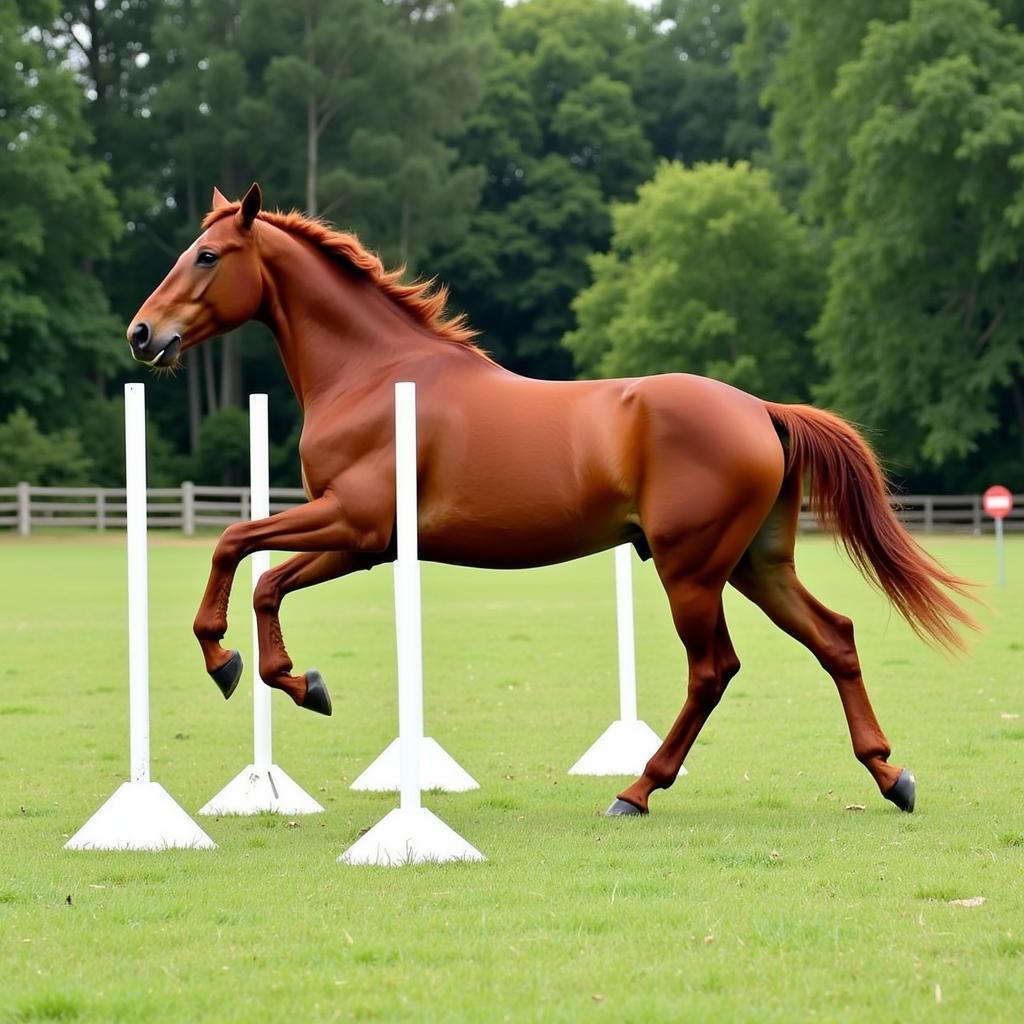Poles For Horses are an essential tool for any equestrian looking to improve their horse’s athleticism, obedience, and overall well-being. Whether you’re a seasoned competitor or a recreational rider, incorporating poles into your training routine can offer a myriad of benefits for both you and your equine partner.
Understanding the Benefits of Poles for Horses
Using poles for horses extends beyond simple obstacle courses. They serve as a versatile training aid, enhancing various aspects of your horse’s physical and mental capabilities.
Enhanced Footwork and Coordination
 Horse Navigating Poles
Horse Navigating Poles
Poles encourage horses to become more aware of their feet, promoting precise foot placement and coordination. This heightened awareness is particularly beneficial for navigating uneven terrain, improving balance, and preventing injuries.
Increased Muscle Strength and Flexibility
 Horse Stretching Over Poles
Horse Stretching Over Poles
Navigating poles, especially raised ones, engages a variety of muscle groups, strengthening the horse’s core, back, and legs. The act of stepping over poles also encourages flexibility, improving range of motion and suppleness.
Mental Stimulation and Engagement
Pole work provides valuable mental stimulation for horses, preventing boredom and encouraging focus. The challenge of navigating poles keeps horses engaged, promoting a positive learning environment and strengthening the bond between horse and rider.
Different Types of Poles for Horses
The term “poles for horses” encompasses a range of equipment designed for equine obstacle training. Here are the most common types:
Ground Poles
ground poles for horses are the most basic type, laid flat on the ground. They’re ideal for introducing young or inexperienced horses to pole work, focusing on rhythm, balance, and basic coordination.
Raised Poles
As the name suggests, raised poles are elevated off the ground using cavaletti blocks or other supports. They increase the difficulty level, encouraging greater muscle engagement, flexibility, and careful footwork.
Trotting Poles
trotting poles for horses are spaced specifically to encourage a rhythmic and balanced trot. They help horses develop a consistent stride, improve back strength, and enhance overall athleticism.
Setting Up Poles for Horse Training
The key to effective pole work lies in proper setup. Here are some essential tips:
- Start Simple: Begin with just a few ground poles, gradually increasing the number and complexity as your horse progresses.
- Spacing is Key: Adjust pole spacing based on your horse’s size and stride. A general guideline for trotting poles is 4.5 to 5 feet apart.
- Safe and Secure: Ensure poles are stable and secure to prevent tripping or injury. Use cavaletti blocks for raised poles and check for any potential hazards in the training area.
Incorporating Poles into Your Training Routine
Poles can be integrated into various training sessions, from basic groundwork to advanced dressage or jumping exercises.
- Warm-up and Cool-down: Use ground poles as part of your warm-up to encourage focus and loosen up muscles. They can also be beneficial for cooling down after strenuous work.
- Obstacle Courses: Create fun and challenging obstacle courses using a combination of ground poles, raised poles, and other obstacles like barrels or cones.
- Dressage Training: Incorporate poles into your dressage training to improve straightness, collection, and transitions.
“Even experienced horses benefit from regular pole work. It’s like a dance routine that keeps their minds and bodies sharp.” – Dr. Emily Carter, Equine Veterinarian
Safety Considerations for Pole Work
While poles offer numerous benefits, safety should always be a top priority.
- Proper Footwear: Ensure your horse is wearing appropriate hoof protection, especially when working with raised poles.
- Gradual Progression: Avoid overwhelming your horse with too much too soon. Introduce new exercises gradually and always end on a positive note.
- Supervise Closely: Always supervise your horse during pole work, especially when introducing new exercises or challenges.
Conclusion
Poles are an invaluable tool for any horse owner looking to enhance their equine partner’s physical and mental well-being. From improved coordination and muscle strength to increased mental engagement and focus, the benefits of pole work are numerous.
Remember to start slowly, gradually increasing the difficulty as your horse progresses. By incorporating poles into your training routine safely and effectively, you’ll unlock a world of possibilities for enhancing your horse’s overall health, performance, and enjoyment of training.
FAQs about Poles for Horses
Q: Can I use poles for horses of all ages and breeds?
A: Yes, poles can be beneficial for horses of all ages and breeds. Adjust the height, spacing, and complexity of exercises to suit your horse’s individual needs and experience level.
Q: How often should I incorporate poles into my horse’s training?
A: You can incorporate poles into your training routine 1-2 times per week. However, always listen to your horse and adjust the frequency and intensity based on their fitness level and recovery needs.
Q: Can I make my own horse poles?
A: While it’s possible to make your own poles, it’s generally recommended to purchase them from reputable equestrian suppliers to ensure durability and safety.
Q: What are some common mistakes to avoid when using poles for horses?
A: Common mistakes include using incorrect pole spacing, progressing too quickly, and not ensuring a safe training environment. Always prioritize safety and seek guidance from an experienced trainer if needed.
Explore More Training Resources
For more insights into equine training and equipment, check out these resources:
Contact us for personalized support at Phone Number: 0772127271, Email: [email protected], or visit our location at QGM2+WX2, Vị Trung, Vị Thuỷ, Hậu Giang, Việt Nam. Our dedicated customer support team is available 24/7 to assist you.